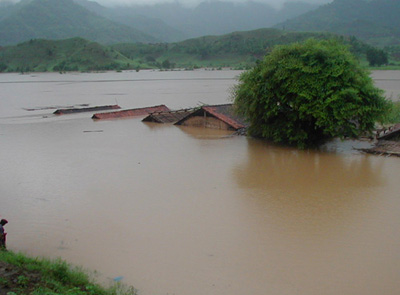
To learn more about the Vanport Flood and its aftermath, view these pages from the Columbia Slough Community History Web site.
Kaiserville: “A Muddy Miracle”
African Americans and Vanport, Oregon

To learn more about the Vanport Flood and its aftermath, view these pages from the Columbia Slough Community History Web site.
Kaiserville: “A Muddy Miracle”
African Americans and Vanport, Oregon
To read Those Who Desired Very Much To Stay, click here
This master’s thesis, written by Melissa E.E. Williams in 2007, explores housing conditions for African Americans in Vancouver,Washington during and after the Second World War. Vancouver’s African American history has been overshadowed by local historians and scholars who study the Portland metropolitan area, as a result, the social conditions and contributions of Vancouver’s black residents have not been fully explored in context of World War II, the Cold War, nor the early Civil Rights Era. This thesis is the author’s attempt to initiate scholarly research about blacks in Southwest Washington State. Vancouver’s black population boomed from 18 in 1940 to nearly 9,000 in 1945 as war industries drew thousands of African Americans to the Pacific Northwest. Vancouver created a housing authority to accommodate all newcomers, in the process initiating the city’s first public housing, which was racially integrated.
At the war’s end, the Housing Authority sold many of its temporary units to scale down its property management, forcing many residents out of its projects and into private homes or to other cities. The permanent units the Vancouver Housing Authority (VHA) had maintained for returned veterans and low-income tenants fell away in 1958 when the Authority turned over its properties to the City of Vancouver.
Because city officials found public housing undesirable their 1950s urban renewal plan platted suburban communities where VHA housing once stood. This redevelopment impacted those black residents who no longer had access to affordable public housing. Concerned citizens in the National Association for the Advancement of Colored People (NAACP), the Young Women’s Christian Association (YWCA), and local churches mobilized during late 1940s and into the 1950s to garner social and municipal support for black home ownership.
Yet despite efforts on the parts of African American individuals and social and civil rights organizations, Vancouver’s black population dropped dramatically as a result of the waning war economy, the loss of affordable public housing, and incidents of racial intolerance. Many African American migrants who had wished to stay in Vancouver after the war’s end found it impossible to settle permanently in the city.
“Dams are the temples of modern India.” Jawarhalal Nehru during a speech after Indian independence in 1947.
The Narmada River is located in the western states of Madya Pradesh and the northeastern state of Gujarat, India.The Sardar Sarovar Dam, begun in 1987 to provide hydroelectric power to Gujarat, is the biggest of 30 dams proposed on the Narmada River.

Above. The Narmada River wends its way across the fertile Nimad Plains famous for its agricultural produce and the breathtaking Satpura hills before crossing Gujarat and into the Arabian Sea. Considered one of India’s holiest rivers, Ma Rewa as it is called is also witness to a unique parikrama or circumambulation by pilgrims walking its entire stretch.
To learn more about the Narmada River and the Sardar Sarovar Dam, download this Narmada River Fact Sheet, which includes a timeline.


Narmada Newsletter updates, July 2005 from Narmada Bachao Andolan, a non-governmental organization (NGO) that mobilized tribal people, adivasis, farmers, environmentalists and human rights activists against the Sardar Sarovar Dam.
Jawarhalal Nehru, speaking to the 1958 annual meeting of the Central Board of Irrigation and Power:
“We want to show that we can build big dams and do big things … but the idea of having big undertakings and doing big tasks for the sake of showing that we can do big things is not a good outlook at all.”
“I have been beginning to think that we are suffering from what we may call disease of giganticism.”
This is a list of selected sources to download in pdf format.
Primary documents associated with the construction of big dams on the Columbia can be found in pdf format in this section.
President Franklin D. Roosevelt’s Speech at the opening of Bonneville Dam, September 28, 1937
“Roll on Columbia,” the Washington State song by Woody Guthrie
William Brophy, Bureau of Indian Affairs Commissioner protests Columbia River development, 1946
The Big Dams Curriculum was developed Big in conjunction with the public conference “Reversing the Flow: Big Dams, Power, and People in Local Context” presented November 6 & 7, 2009 in Vancouver, Washington, and available here.
Using this Big Dam History Detectives Scaffolding Exercise educators can help students of all ages to follow a trail of historical discovery connected to building big dams and their impacts in the Columbia Basin and worldwide.
This curriculum includes Big Dam fact sheets for regional and world dams, primary documents, photographs, and video lectures from the big dams conference. Students can also work with a variety of resources on the CCRH website to explore the history and impacts of big dams, including the CCRH community history sites located on the community history section of the CCRH website.
Each of the eight Web sites features extensive primary sources, including maps, oral history interviews, documents, newspapers, and photographs. Bibliographies contribute additional information about each community, and audio excerpts and curriculum questions enrich the exhibit tour.
Community History sites include:
World Dam Resources – images, documents, timelines, fact sheets, and talks.